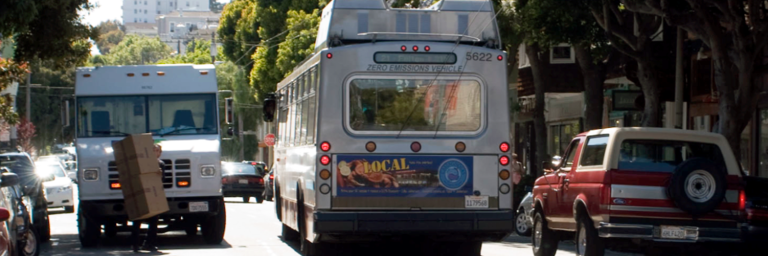When we don't provide enough loading zones in the right places, people double-park to load and unload, creating safety hazards and disrupting traffic and transit, andbusinesses have trouble getting customers and goods to their front door. The Sustainable Streets Division Parking and Curb Management team has developed a Curb Management Strategy to guide the SFMTA's policies towards the curb. The team is also working on specific curb management projects across the City to improve the way our streets function. Holistic, proactive curb management can help promote safety, improve transit reliability and disabled access, reduce congestion, and support business vitality.
Curb Management Strategy
The Curb Management team has developed the Curb Management Strategy to guide the SFMTA’s decision-making when it comes to allocating curb space to different uses. The document builds on work by others across the country, including curb management guides developed by the National Association of City Transportation Officials (NACTO) and the Institute of Transportation Engineers (ITE).
The Strategy includes a framework for prioritizing different needs in different parts of the city as well as recommendations for legislative changes, internal SFMTA process improvements, and guidelines for the physical design of loading zones. The document was developed through close collaboration with other staff across the SFMTA and sister agencies, as well as extensive outreach to stakeholders. It was adopted by the SFMTA Board in February 2020.
Curb Management Projects
The Curb Management team has implemented projects across the city to test different curb management tools and respond to local needs. Some recent projects have included:
- 22nd Street Caltrain Station: The streets around this important transit hub had no parking regulations. Staff added passenger loading zones, dedicated motorcycle parking, secure bike parking, and parking meters in the surrounding area to make it easier to safely access the station.
- Oracle Park and Chase Center: The SFMTA implemented new loading zones near the San Francisco Giants stadium and worked with taxis and transportation network company (TNC) providers to ensure drivers and riders use them correctly. Similarly, the curb management team worked with other parts of the Agency and external stakeholders to develop an extensive curb management plan for the area around the Chase Center, the new Golden State Warriors basketball arena, before it opened in 2019. Those changes helped ensure that transit, bikes, and traffic continue to flow smoothly, even during major events.
- Inner Sunset: In January 2020, the SFMTA Board approved the Inner Sunset Curb Management Project, a community- and merchant-led project to improve the allocation of loading and parking regulations in the busy neighborhood commercial district around 9th Avenue and Irving Street. The project will be implemented later in 2020.
- 10th and 11th Street: On 10th and 11th Streets just south of Market, there was very high passenger loading demand but little space allocated to it, so people double parked in the bike lane, in front of the bus, and in the travel lane. In 2019, staff reconfigured the curb to create larger, more usable passenger loading zones, as well as improving the Muni flag stop, adding commercial loading and short-term parking space, and realigning travel lanes to improve safety. Other similar improvements have been made on streets throughout the greater Downtown area associated with the early implementation of Better Market Street in early 2020.
